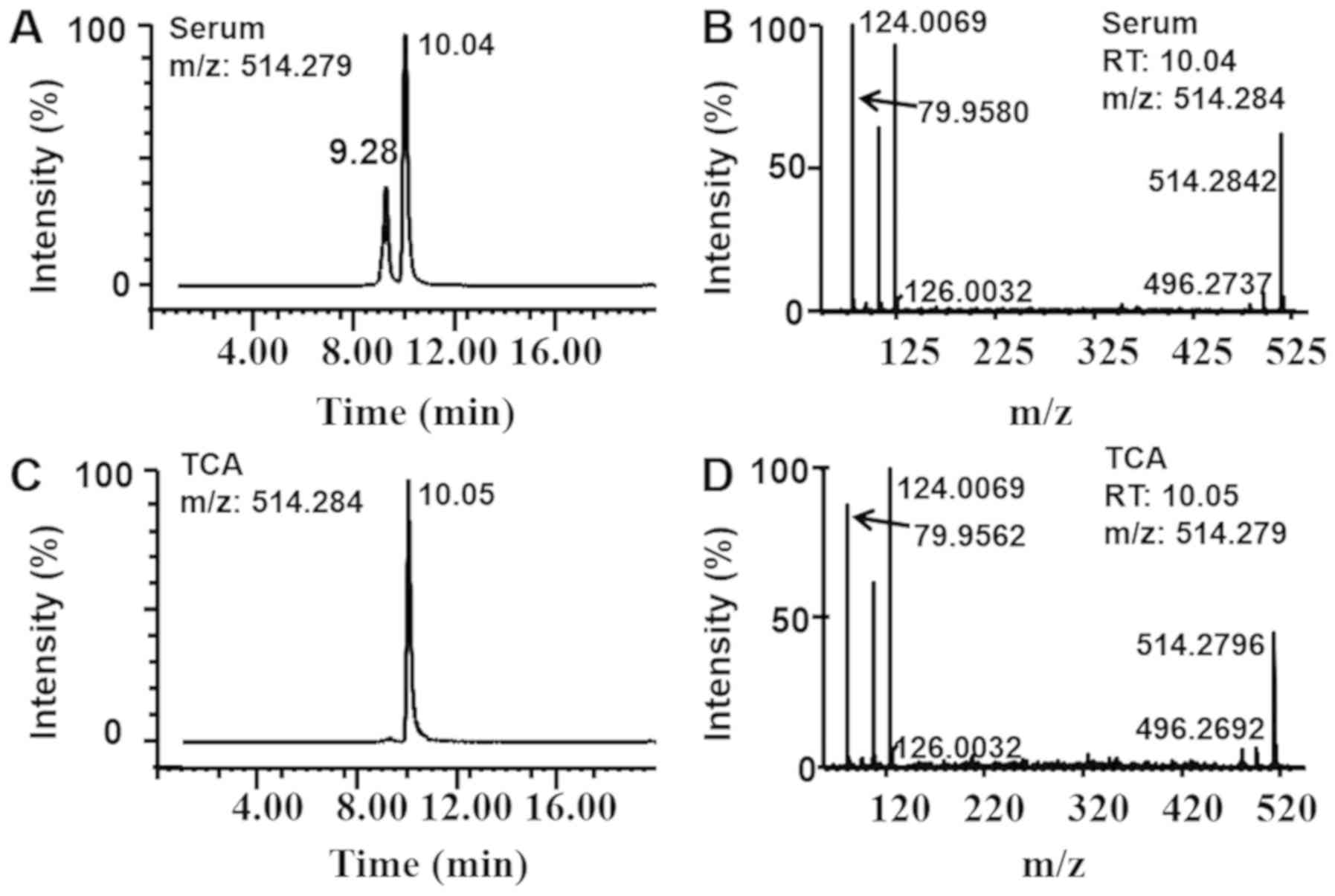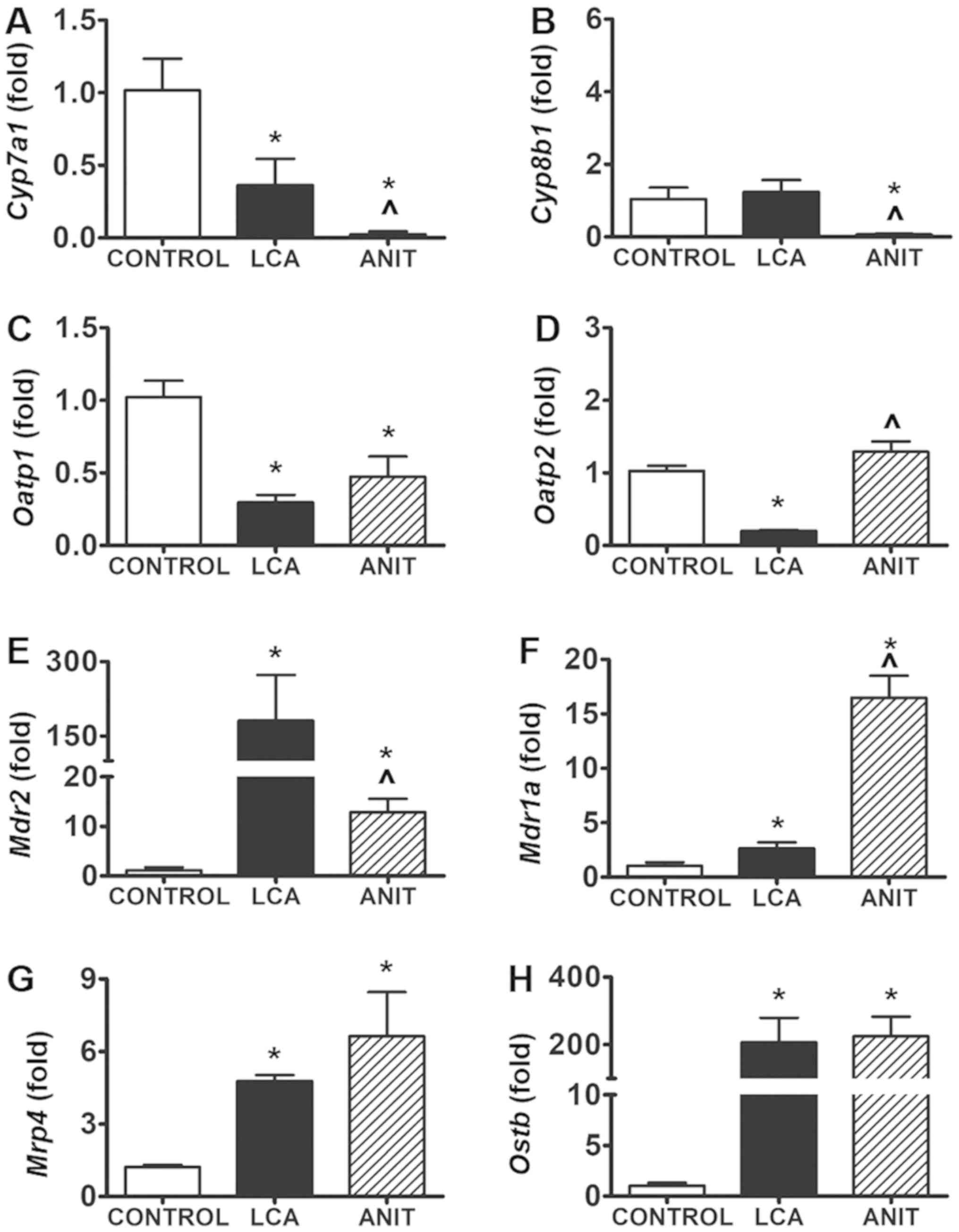|
1
|
Hirschfield GM, Heathcote EJ and Gershwin
ME: Pathogenesis of cholestatic liver disease and therapeutic
approaches. Gastroenterology. 139:1481–1496. 2010. View Article : Google Scholar : PubMed/NCBI
|
|
2
|
Poupon R: Primary biliary cirrhosis: A
2010 update. J Hepatol. 52:745–758. 2010. View Article : Google Scholar : PubMed/NCBI
|
|
3
|
Liu H, Liu Y, Wang L, Xu D, Lin B, Zhong
R, Gong S, Podda M and Invernizzi P: Prevalence of primary biliary
cirrhosis in adults referring hospital for annual health check-up
in Southern China. BMC Gastroenterol. 10:1002010. View Article : Google Scholar : PubMed/NCBI
|
|
4
|
Lindkvist B, Benito de Valle M, Gullberg B
and Bjornsson E: Incidence and prevalence of primary sclerosing
cholangitis in a defined adult population in Sweden. Hepatology.
52:571–577. 2010. View Article : Google Scholar : PubMed/NCBI
|
|
5
|
Claessen MM, Vleggaar FP, Tytgat KM,
Siersema PD and van Buuren HR: High lifetime risk of cancer in
primary sclerosing cholangitis. J Hepatol. 50:158–164. 2009.
View Article : Google Scholar : PubMed/NCBI
|
|
6
|
Tischendorf JJ, Hecker H, Kruger M, Manns
MP and Meier PN: Characterization, outcome, and prognosis in 273
patients with primary sclerosing cholangitis: A single center
study. Am J Gastroenterol. 102:107–114. 2007. View Article : Google Scholar : PubMed/NCBI
|
|
7
|
Zhang A, Jia Y, Xu Q, Wang C, Liu Q, Meng
Q, Peng J, Sun H, Sun P, Huo X and Liu K: Dioscin protects against
ANIT-induced cholestasis via regulating Oatps, Mrp2 and Bsep
expression in rats. Toxicol Appl Pharmacol. 305:127–135. 2016.
View Article : Google Scholar : PubMed/NCBI
|
|
8
|
Zhou HQ, Liu W, Wang J, Huang YQ, Li PY,
Zhu Y, Wang JB, Ma X, Li RS, Wei SZ, et al: Paeoniflorin attenuates
ANIT-induced cholestasis by inhibiting apoptosis in vivo via
mitochondria-dependent pathway. Biomed Pharmacother. 89:696–704.
2017. View Article : Google Scholar : PubMed/NCBI
|
|
9
|
Tan Z, Liu A, Luo M, Yin X, Song D, Dai M,
Li P, Chu Z, Zou Z, Ma M, et al: Geniposide inhibits
alpha-naphthylisothiocyanate-induced intrahepatic cholestasis: The
downregulation of STAT3 and NF[formula: See text]B signaling plays
an important role. Am J Chin Med. 44:721–736. 2016. View Article : Google Scholar : PubMed/NCBI
|
|
10
|
Connolly AK, Price SC, Connelly JC and
Hinton RH: Early changes in bile duct lining cells and hepatocytes
in rats treated with alpha-naphthylisothiocyanate. Toxicol Appl
Pharmacol. 93:208–219. 1988. View Article : Google Scholar : PubMed/NCBI
|
|
11
|
Dai M, Yang J, Xie M, Lin J, Luo M, Hua H,
Xu G, Lin H, Song D, Cheng Y, et al: Inhibition of JNK signalling
mediates PPARalpha-dependent protection against intrahepatic
cholestasis by fenofibrate. Br J Pharmacol. 174:3000–3017. 2017.
View Article : Google Scholar : PubMed/NCBI
|
|
12
|
Li X, Liu R, Yu L, Yuan Z, Sun R, Yang H,
Zhang L and Jiang Z: Alpha-naphthylisothiocyanate impairs bile acid
homeostasis through AMPK-FXR pathways in rat primary hepatocytes.
Toxicology. 370:106–115. 2016. View Article : Google Scholar : PubMed/NCBI
|
|
13
|
Zeng H, Li D, Qin X, Chen P, Tan H, Zeng
X, Li X, Fan X, Jiang Y, Zhou Y, et al: Hepatoprotective effects of
schisandra sphenanthera extract against lithocholic acid-induced
cholestasis in male mice are associated with activation of the
pregnane X receptor pathway and promotion of liver regeneration.
Drug Metab Dispos. 44:337–342. 2016. View Article : Google Scholar : PubMed/NCBI
|
|
14
|
Zhang X, Ma Z, Liang Q, Tang X, Hu D, Liu
C, Tan H, Xiao C, Zhang B, Wang Y, et al: Tanshinone IIA exerts
protective effects in a LCA-induced cholestatic liver model
associated with participation of pregnane X receptor. J
Ethnopharmacol. 164:357–367. 2015. View Article : Google Scholar : PubMed/NCBI
|
|
15
|
Woolbright BL, Li F, Xie Y, Farhood A,
Fickert P, Trauner M and Jaeschke H: Lithocholic acid feeding
results in direct hepato-toxicity independent of neutrophil
function in mice. Toxicol Lett. 228:56–66. 2014. View Article : Google Scholar : PubMed/NCBI
|
|
16
|
El-Agamy DS, Almaramhy HH, Ahmed N, Bojan
B, Alrohily WD and Elkablawy MA: Anti-inflammatory effects of
vardenafil against cholestatic liver damage in mice: A mechanistic
study. Cell Physiol Biochem. 47:523–534. 2018. View Article : Google Scholar : PubMed/NCBI
|
|
17
|
Kong Y, Gao X, Wang C, Ning C, Liu K, Liu
Z, Sun H, Ma X, Sun P and Meng Q: Protective effects of yangonin
from an edible botanical Kava against lithocholic acid-induced
cholestasis and hepatotoxicity. Eur J Pharmacol. 824:64–71. 2018.
View Article : Google Scholar : PubMed/NCBI
|
|
18
|
Dai M, Hua H, Lin H, Xu G, Hu X, Li F,
Gonzalez FJ, Liu A and Yang J: Targeted metabolomics reveals a
protective role for basal PPARα in cholestasis induced by
α-naphthylisothiocyanate. J Proteome Res. 17:1500–1508. 2018.
View Article : Google Scholar : PubMed/NCBI
|
|
19
|
Livak KJ and Schmittgen TD: Analysis of
relative gene expression data using real-time quantitative PCR and
the 2(-Delta Delta C(T)) method. Methods. 25:402–408. 2001.
View Article : Google Scholar : PubMed/NCBI
|
|
20
|
Melanie S, Benedikt K, Pfaffl MW and
Irmgard R: The potential of circulating extracellular small RNAs
(smexRNA) in veterinary diagnostics-Identifying biomarker
signatures by multivariate data analysis. Biomol Detect Quantif.
5:15–22. 2015. View Article : Google Scholar : PubMed/NCBI
|
|
21
|
Waner T and Nyska A: The toxicological
significance of decreased activities of blood alanine and aspartate
aminotransferase. Vet Res Commun. 15:73–78. 1991. View Article : Google Scholar : PubMed/NCBI
|
|
22
|
Ning T, Guo J, Zhang K, Li K, Zhang J,
Yang Z and Ge Z: Nanosecond pulsed electric fields enhanced
chondrogenic potential of mesenchymal stem cells via JNK/CREB-STAT3
signaling pathway. Stem Cell Res Ther. 10:452019. View Article : Google Scholar : PubMed/NCBI
|
|
23
|
Golbar HM, Izawa T, Yano R, Ichikawa C,
Sawamoto O, Kuwamura M, Lamarre J and Yamate J: Immunohistochemical
characterization of macrophages and myofibroblasts in
α-Naphthylisothiocyanate (ANIT)-induced bile duct injury and
subsequent fibrogenesis in rats. Toxicol Pathol. 39:795–808. 2011.
View Article : Google Scholar : PubMed/NCBI
|
|
24
|
Lleo A, Maroni L, Glaser S, Alpini G and
Marzioni M: Role of cholangiocytes in primary biliary cirrhosis.
Semin Liver Dis. 34:273–284. 2014. View Article : Google Scholar : PubMed/NCBI
|
|
25
|
Deo AK and Bandiera SM: Biotransformation
of lithocholic acid by rat hepatic microsomes: Metabolite analysis
by liquid chromatography/mass spectrometry. Drug Metab Dispos.
36:442–451. 2008. View Article : Google Scholar : PubMed/NCBI
|
|
26
|
Aithal GP, Watkins PB, Andrade RJ, Larrey
D, Molokhia M, Takikawa H, Hunt CM, Wilke RA, Avigan M, Kaplowitz
N, et al: Case definition and phenotype standardization in
drug-induced liver injury. Clin Pharmacol Ther. 89:806–815. 2011.
View Article : Google Scholar : PubMed/NCBI
|
|
27
|
Meng Q, Chen XL, Wang CY, Liu Q, Sun HJ,
Sun PY, Huo XK, Liu ZH, Yao JH and Liu KX: Alisol B 23-acetate
protects against ANIT-induced hepatotoxity and cholestasis, due to
FXR-mediated regulation of transporters and enzymes involved in
bile acid homeostasis. Toxicol Appl Pharmacol. 283:178–186. 2015.
View Article : Google Scholar : PubMed/NCBI
|
|
28
|
Miyata M, Watase H, Hori W, Shimada M,
Nagata K, Gonzalez FJ and Yamazoe Y: Role for enhanced faecal
excretion of bile acid in hydroxysteroid sulfotransferase-mediated
protection against lithocholic acid-induced liver toxicity.
Xenobiotica. 36:631–644. 2006. View Article : Google Scholar : PubMed/NCBI
|
|
29
|
Bodin K, Lindbom U and Diczfalusy U: Novel
pathways of bile acid metabolism involving CYP3A4. Biochim Biophys
Acta. 1687:84–93. 2005. View Article : Google Scholar : PubMed/NCBI
|
|
30
|
Lu TT, Makishima M, Repa JJ, Schoonjans K,
Kerr TA, Auwerx J and Mangelsdorf DJ: Molecular basis for feedback
regulation of bile acid synthesis by nuclear receptors. Mol Cell.
6:507–515. 2000. View Article : Google Scholar : PubMed/NCBI
|
|
31
|
Sun L, Xie C, Wang G, Wu Y, Wu Q, Wang X,
Liu J, Deng Y, Xia J, Chen B, et al: Gut microbiota and intestinal
FXR mediate the clinical benefits of metformin. Nat Med.
24:1919–1929. 2018. View Article : Google Scholar : PubMed/NCBI
|
|
32
|
Yu SJ, Bae S, Kang JS, Yoon JH, Cho EJ,
Lee JH, Kim YJ, Lee WJ, Kim CY and Lee HS: Hepatoprotective effect
of vitamin C on lithocholic acid-induced cholestatic liver injury
in Gulo(−/-) mice. Eur J Pharmacol. 762:247–255. 2015. View Article : Google Scholar : PubMed/NCBI
|
|
33
|
Roth RA and Dahm LJ: Neutrophil- and
glutathione-mediated hepatotoxicity of
alpha-naphthylisothiocyanate. Drug Metab Rev. 29:153–165. 1997.
View Article : Google Scholar : PubMed/NCBI
|
|
34
|
Essani NA, Fisher MA, Farhood A, Manning
AM, Smith CW and Jaeschke H: Cytokine-induced upregulation of
hepatic intercellular adhesion molecule-1 messenger RNA expression
and its role in the pathophysiology of murine endotoxin shock and
acute liver failure. Hepatology. 21:1632–1639. 1995. View Article : Google Scholar : PubMed/NCBI
|
|
35
|
Woolbright BL and Jaeschke H: Therapeutic
targets for cholestatic liver injury. Exp Opin Ther Targets.
20:463–475. 2016. View Article : Google Scholar
|
|
36
|
Woolbright BL and Jaeschke H: Inflammation
and cell death during cholestasis: The evolving role of bile acids.
Gene Expr. 19:215–228. 2019. View Article : Google Scholar : PubMed/NCBI
|
|
37
|
Lou G, Ma X, Fu X, Meng Z, Zhang W, Wang
YD, Van Ness C, Yu D, Xu R and Huang W: GPBAR1/TGR5 mediates bile
acid-induced cytokine expression in murine Kupffer cells. PLoS One.
9:e935672014. View Article : Google Scholar : PubMed/NCBI
|
|
38
|
Cai SY, Ouyang X, Chen Y, Soroka CJ, Wang
J, Mennone A, Wang Y, Mehal WZ, Jain D and Boyer JL: Bile acids
initiate cholestatic liver injury by triggering a
hepatocyte-specific inflammatory response. JCI Insight.
2:e907802017. View Article : Google Scholar : PubMed/NCBI
|
|
39
|
Woolbright BL, Dorko K, Antoine DJ, Clarke
JI, Gholami P, Li F, Kumer SC, Schmitt TM, Forster J, Fan F, et al:
Bile acid-induced necrosis in primary human hepatocytes and in
patients with obstructive cholestasis. Toxicol Appl Pharmacol.
283:168–177. 2015. View Article : Google Scholar : PubMed/NCBI
|
|
40
|
Li C, Yan Y, Shi Q, Kong Y, Gao L, Bao H
and Li Y: Recuperating lung decoction attenuates inflammation and
oxidation in cigarette smoke-induced COPD in rats via activation of
ERK and Nrf2 pathways. Cell Biochem Funct. 35:278–286. 2017.
View Article : Google Scholar : PubMed/NCBI
|
|
41
|
Zhang W, Dai H, Lin F, Zhao C, Wang X,
Zhang S, Ge W, Pei S and Pan L: Ly-6C(high) inflammatory-monocyte
recruitment is regulated by p38 MAPK/MCP-1 activation and promotes
ventilator-induced lung injury. Int Immunopharmacol. 78:1060152020.
View Article : Google Scholar : PubMed/NCBI
|


















